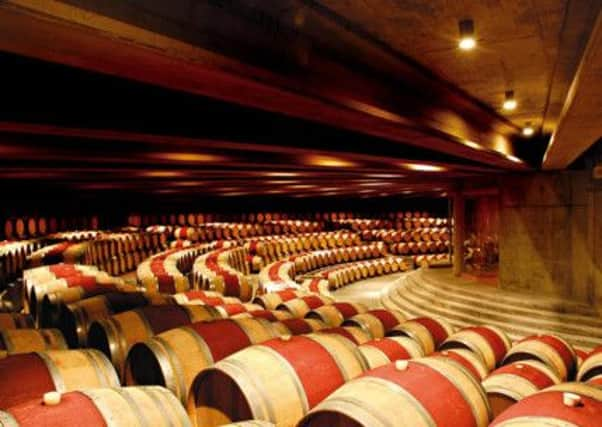Wine Club: Chile where breeze blows


The Chilean seaside resort of Zapallar is famous for many things, not least the quality of the seafood hauled out of the Pacific each day and served up at local restaurants. There is everything you might recognise and quite a lot I certainly didn’t, including sea bass, purple crabs, razor clams, pink clams and scallops.
Zapallar is also rather an exclusive place to have a holiday villa. These cling to the cliffs, enjoying fabulous views out across the ocean. But there are surprisingly few people actually on the beach. A few hardy souls brave the cold water, but the cool breeze cuts through the sunshine and keeps temperatures down.
Advertisement
Hide AdAdvertisement
Hide AdJust four miles inland, the wild, untamed hillsides suddenly turn green as the regimented lines of a newly planted 45-hectare vineyard come into view. This is the latest project by Aurelio Montes who has decided to harness this unique combination of sunshine and cool breezes to establish the new wine region of Zapallar.
“I was looking for somewhere to grow Sauvignon Blanc and Pinot Noir and Zapallar has a wonderful climate where grapes can ripen slowly and keep their fresh, fruity flavours,” he said.
This is evident in the wines, labelled Outer Limits. The 2014 Sauvignon Blanc was bright and fresh-tasting with grapefruit, asparagus and green, grassy flavours backed by a fantastic streak of crunchy minerality and a silky, generous texture. The Pinot 2012 was elegant, perhaps still a little young-tasting but with the promise of more density as the vines gather age and complexity.
The name Outer Limits was chosen not just because of the extreme nature of the region, but because it also includes wines from challenging vineyards elsewhere in Chile. There is a Cinsault from old vineyards in Itata, 400km south of Santiago. “We found these century-old vineyards that were producing wine for local consumption and had to work hard to persuade the owners to let us buy the grapes, even at five times the usual price,” said Aurelio. Each vine produces tiny bunches of grapes which are made into a fabulous, concentrated, herb-streaked, wild red-berry flavoured wine. It is joyously different from European Cinsaults.
Advertisement
Hide AdAdvertisement
Hide AdOuter Limits wines are not mass-produced and they are spread thinly around retailers, but they demonstrate the high level of quality that is possible in Chile. Corking Wines, based in York (01904 622574, www.corkingwines.co.uk), has some of the range, including an unusual Carignan, Grenache and Mourvèdre blend from Apalta.
“Chile is still a country to be discovered and talked about,” said Aurelio, firmly dismissing the idea that it is just a producer of low-cost Cabernet and Merlot.
Finding new places to grow grapes is an obsession for him. South of Zapallar, close to the newly-built Montes winery in Colchagua, he has extended his search to Marchigüe. Here he has a vast expanse of 2,000 hectares and has planted just under a third of it, leaving gaps for streams, trees and the occasional tall, prickly cactus. This region is in a rain-shadow so natural rainfall is low, and while water is available from the 15 deep wells dug on the estate, the vines are essentially dry-farmed.
“This is our sustainability initiative to cut down on water use in vineyards and learn how the vines respond to less irrigation. We only irrigate in the first few years after planting, to allow the vines to get established and then we remove the pipes and let the vines adapt to dry farmed conditions. Dry-farming is part of our sustainability project, to protect the nature of the site,” said Aurelio. Using different pruning techniques and accepting smaller bunches of grapes and much smaller yields, the quality of this area is now emerging.
Advertisement
Hide AdAdvertisement
Hide AdSix hectares of this estate is set aside for the production of Taita, the super-icon wine from Montes. The site is based on decomposed granitic soil, left behind several millennia ago by a receding glacier, and the wine is Cabernet Sauvignon based with a small percentage of Syrah and Carmenère. Dry-farming has given this wine deep concentration and flavours of blackberry, chocolate and truffle. At around £180 a bottle, it may make its way to the UK, but for now the Asian market seems to be snapping it up.
Despite the expansion of vineyards in the north and south, the broad sweep of Apalta in Colchagua is where Montes has its home. This was my first visit to the new winery, built to top environmental standards but designed with the natural energy of Feng Shui in mind. There is water in all the right places, a backdrop of mountains acting as a “dragon” protecting the site and various colours, aspects and stones all provide the right balance, but I was more impressed by the quality of the tanks and the barrel room.
“Does Feng Shui actually make the wine any better,” I asked Aurelio over the gentle Gregorian chanting he has playing to his wines while they mature in barrel. “The building is beautiful and it works well, but for me, I don’t think the wine will be any better for it. However, the harmony and balance in this winery does make people happy and happy people work well.”
The range of Montes wines is available at Martinez Wines in Ilkley and I particularly like the Cabernet Sauvignon 2010 (£8.99) for its deep cassis fruit, with silky tannins. Wine merchant Majestic stocks Montes Alpha Merlot 2012, a rich, complex wine with plum and cherry fruit with notes of coffee and tobacco (normally £12.99, down to £9.74 on multi-buy). Majestic can also boast the Alpha Chardonnay 2013 (£12.99 down to £9.74) which seems to have shrugged off the oak overcoat that used to dominate its flavours and now shines with mango, melon and pineapple fruit, complex and minerality.